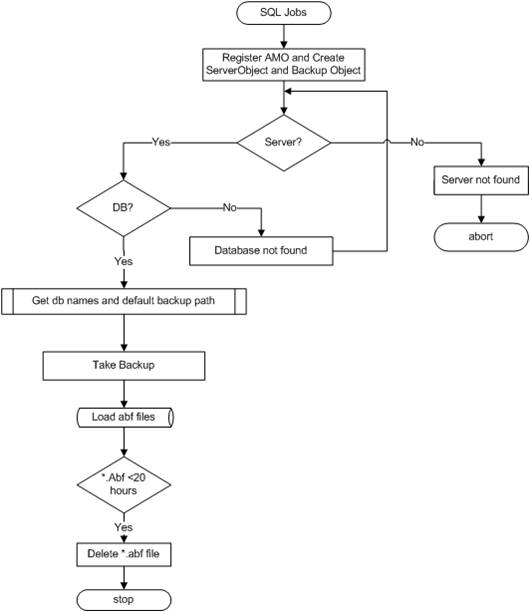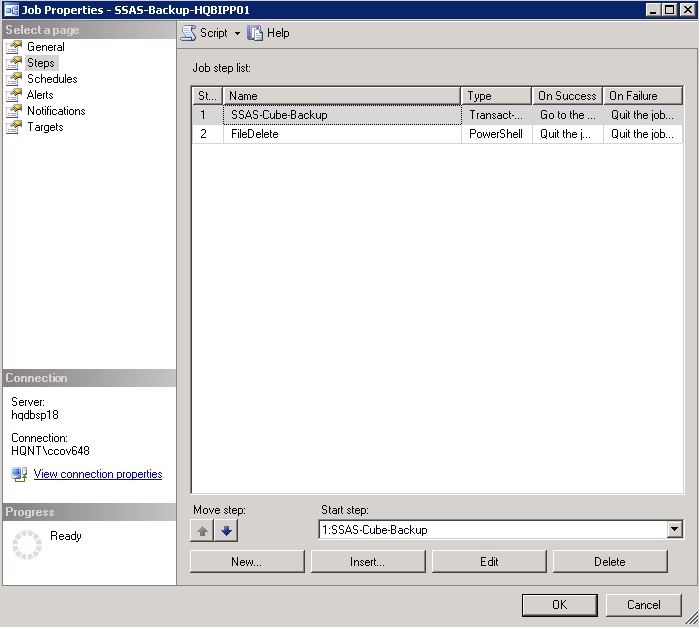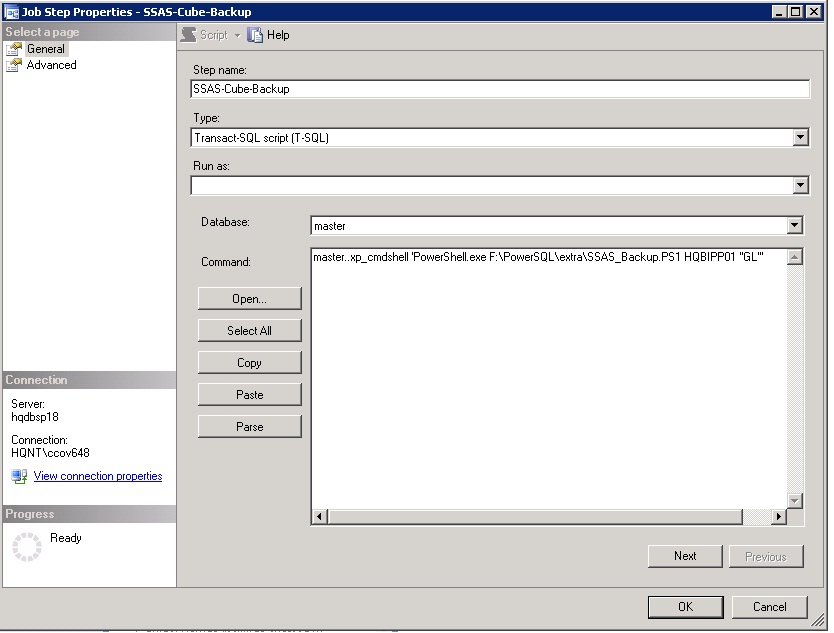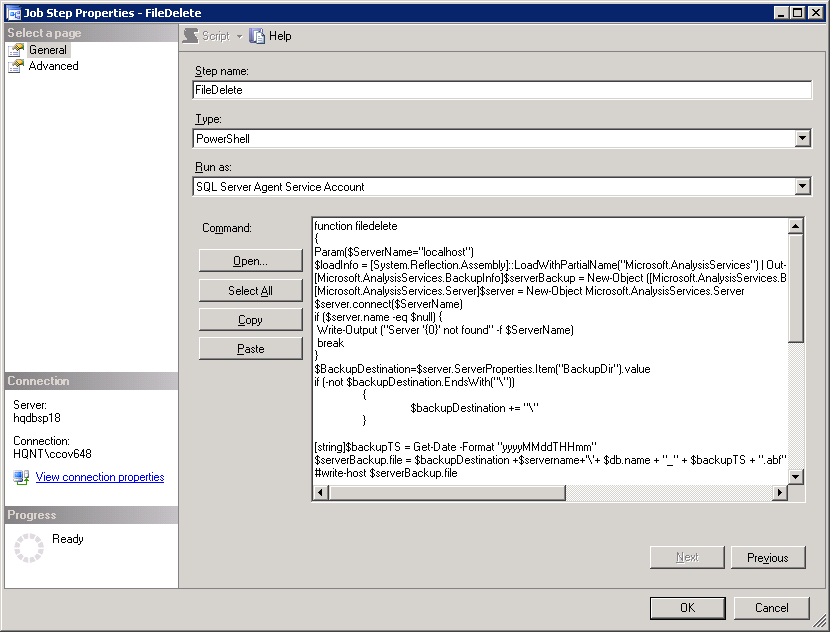SSAS - Discuss various backup methods & Automating cube database(s) backup with PowerShell
** **
**
 This article awarded Technet GURU gold medal. You are welcome to update the article as needed
This article awarded Technet GURU gold medal. You are welcome to update the article as needed
**
Introduction
One of the most important responsibilities of a database administrator is to make sure that all(Relational and OLAP) databases are backed up across environments. SSAS backup has a different set of retention and DR requirements to OLTP DB's due to their nature. SSAS databases can still be mission critical so we need to consider backup options carefully. This post discusses various options and methodology which can be used to initiate SSAS backup.
There are different ways to take Cube database backup. The different methods are given below(PS:Reference section for First four methods)
- **SSMS **
- SSAS backups can be performed manually through SQL Server Management Studio, SSMS Basic Method
- SQL Agent Job
- XMLA script for backup, XMLA and ASCMD
- using ASCMD
- ASCMD command
- **SSIS **
- SSIS package, SSIS
- AMO (Analysis Management Objects
- PowerShell Scripts
This article talks about AMO (Analysis Management Objects) and it’s advantages in making life easier. Analysis Management Objects (AMO) is the complete library of programmatically accessed objects that enables an application to manage a running instance of Microsoft SQL Server Analysis Services
PowerShell script is used for backup cube databases using AMO classes. The script will backup all/specific databases of an instance to default backup location/local/remote or n/w share and manage the backup files as per the retention period data.
The Power Shell script executed from the local machine where it connects to remote server and places the files (*.abf) to it's respective backup folder (Default location For eg:- F:\Program Files\Microsoft SQL Server\MSSQL.1\OLAP\Backup\.
Pre-requisites
- Setting execution policy Execution Policy PowerShell
- Load modules if it’s not loaded automatically
- Full rights on file share or local or remote location
Logical Flow
Method 1 : Input text file consists of Cube DB's, Backup to local drive
This method traverse through a file for listed cube database and initiate backup to a default backup folder.
The pre-requisites are
- Input file
- Powershell script saved as SSAS1.ps1
- Drive Space, though compression is enabled in the script make sure that you've enough space on the target drive
The database cube names are listed in c:\SSAS\CubeList.txt file. PowerShell script(SSAS1.PS1) traverse through each cube database for backup.
CubeList.txt must contains the cube databases
ABC
CDEF
GHI
Copy and Paste the code into text file and save as SSAS1.PS1
Param($ServerName="localhost",[String]$inputfile )
$loadInfo = [System.Reflection.Assembly]::LoadWithPartialName("Microsoft.AnalysisServices") | Out-Null
## Add the AMO namespace
[Microsoft.AnalysisServices.BackupInfo]$serverBackup = New-Object ([Microsoft.AnalysisServices.BackupInfo])
[Microsoft.AnalysisServices.Server]$server = New-Object Microsoft.AnalysisServices.Server
$server.connect($ServerName)
If ($server.name -eq $null)
{
Write-Output ("Server '{0}' not found" -f $ServerName)
break
}
$DBList = Get-Content $inputfile
Foreach($DBName in $DBList)
{
$DB = $server.Databases.FindByName($DBName)
if ($DB -eq $null)
{
Write-Output ("Database '{0}' not found" -f $DBName)
}
else
{
Write-Output("----------------------------------------------------------------")
Write-Output("Server : {0}" -f $Server.Name)
Write-Output("Database: {0}" -f $DB.Name)
Write-Output("DB State: {0}" -f $DB.State)
Write-Output("DB Size : {0}MB" -f ($DB.EstimatedSize/1024/1024).ToString("#,##0"))
Write-Output("----------------------------------------------------------------")
$BackupDestination=$server.ServerProperties.Item("BackupDir").value
$serverBackup.AllowOverwrite = 1
$serverBackup.ApplyCompression = 1
$serverBackup.BackupRemotePartitions = 1
if (-not $backupDestination.EndsWith("\"))
{
$backupDestination += "\"
}
[string]$backupTS = Get-Date -Format "yyyyMMddHHmm"
$serverBackup.file = $backupDestination + $db.name + "_" + $backupTS + ".abf"
$serverBackup.file
$db.Backup($serverBackup)
if ($?) {"Successfully backed up " + $db.Name + " to " + $serverBackup.File }
else {"Failed to back up " + $db.Name + " to " + $serverBackup.File }
}
}
$server.Disconnect()
Syntax:-
PS C:\SSAS> .\SSAS1.PS1 -servername <ServerName> -inputfile <InputFileName>
Sample call example:-
**
**
PS:\>.\SSAS-Backup.PS1 -ServerName HQBIPP01 -inputfile c:\ssas\HQBIPP01DB.txt
Method 2: Pass cube server ,database and retention period as it’s parameters
This process backup each listed cube database and delete the corresponding backup entry depending on the retention parameter also the process creates a backup folder(ServerName) in the default backup folder
The pre-requisites are
- Powershell script saved as Backup-SSAS.ps1
- Drive Space, though compression is enabled in the script make sure that you've enough space on the target drive
- Retention Period by default its 10 days
Copy and Paste the code into Backup-SSAS.ps1
**
**
###### Configuration ######
# FQDN of Analysis Services server. If no server name is specified thendefaults to localhost.
#backup_location is the default backup folder
# Only specified database will be backed-up.
# How long backups will be retained, by default its 15
##### End Configuration ######
param([String]$ServerName="localhost", [String]$DBName="", [int]$RetentionPeriod=15 )
## Add the AMO namespace
$loadInfo = [System.Reflection.Assembly]::LoadWithPartialName("Microsoft.AnalysisServices") | Out-Null
[Microsoft.AnalysisServices.BackupInfo]$serverBackup = New-Object ([Microsoft.AnalysisServices.BackupInfo])
[Microsoft.AnalysisServices.Server]$server = New-Object Microsoft.AnalysisServices.Server
$server.connect($ServerName)
if ($server.name -eq $null) {
Write-Output ("Server '{0}' not found" -f $ServerName)
break
}
$DB = $server.Databases.FindByName($DBName)
if ($DB -eq $null) {
Write-Output ("Database '{0}' not found" -f $DBName)
break
}
Write-Output("----------------------------------------------------------------")
Write-Output("Server : {0}" -f $Server.Name)
Write-Output("Database: {0}" -f $DB.Name)
Write-Output("DB State: {0}" -f $DB.State)
Write-Output("DB Size : {0}MB" -f ($DB.EstimatedSize/1024/1024).ToString("#,##0"))
Write-Output("----------------------------------------------------------------")
$BackupDestination=$server.ServerProperties.Item("BackupDir").value
$serverBackup.AllowOverwrite = 1
$serverBackup.ApplyCompression = 1
$serverBackup.BackupRemotePartitions = 1
if (-not $backupDestination.EndsWith("\"))
{
$backupDestination += "\"
}
[string]$backupTS = Get-Date -Format "yyyyMMddHHmm"
$serverBackup.file = $backupDestination +$servername+'\'+ $db.name + "_" + $backupTS + ".abf"
$serverBackup.file
$db.Backup($serverBackup)
if ($?) {"Successfully backed up " + $db.Name + " to " + $serverBackup.File }
else {"Failed to back up " + $db.Name + " to " + $serverBackup.File }
$server.Disconnect()
$drive=$serverBackup.file.substring(0,1)
$path='$serverBackup.file | Measure-Object -Character |select characters'
$path=$serverBackup.file.substring(2,$path.characters)
write-host $path
$file=get-ChildItem \\$servername\$Drive$\$path -recurse -Filter $DBName*.abf | Select-object LastWriteTime,directoryname,name | where-object {$_.LastWriteTime -lt [System.DateTime]::Now.AddDays(-$RetentionPeriod)}
foreach($f in $file)
{
$filename=$f.directoryname+'\'+$f.name
write-host 'File deleted' $filename
remove-item $filename -Force
}
**Syntax:-
**
PS:\>.\Backup-SSAS.ps1 -ServerName <ServerName> -DBName <DBName> -RetentionPeriod <InDays>
Sample call:-
PS:\>.\Backup-SSAS.ps1 -ServerName hqbipp01 -DBName GL -RetentionPeriod 1
Output:-
**
Method 3: Backup all cube database to Network Share
###### Configuration ######
# FQDN of Analysis Services server. If no server name is specified then
# defaults to localhost. example: $server_name = "ssas1.microsoft.com"
$server_name = $null
# UNC path of share or on-disk location to which backups will be stored.
# Do not including trailing slash. If null then defaults to SSAS BackupDir
# example: $backup_location = "\\storage.microsoft.com\ssas-backup"
$backup_location = $null
# Array of databases that will be backed-up. If $null then all databases
# will be backed up.
$user_requested_databases = $null
# How long backups will be retained
$retention_period_in_days = 30
###### End Configuration ######
trap [Exception] {
write-error $("TRAPPED: " + $_.Exception.GetType().FullName)
write-error $("TRAPPED: " + $_.Exception.Message)
if ($server) {
$server.disconnect()
}
exit 1
}
if ($server_name -eq $null) {
$server_name = "localhost"
}
[System.Reflection.Assembly]::LoadWithPartialName("Microsoft.AnalysisServices") | out-null
$server = New-Object Microsoft.AnalysisServices.Server
$server.connect($server_name)
# Set the directory for backups to the server property
# "BackupDir" if it's not otherwise specified
if ($backup_location -eq $null) {
$backup_location = ($server.get_ServerProperties() | Where {$_.Name -eq "BackupDir"}).Value}
elseif (!(Test-Path -path $backup_location)) {
throw "Specified path ($backup_location) does not exist."
}
# Generate an array of databases to be backed up
$available_databases = ($server.get_Databases() | foreach {$_.Name})
if ($user_requested_databases -eq $null) {
$databases = $available_databases}
else {
$databases = $user_requested_databases.Split(",")
# Check that all specified databases actually exist on the server.
foreach ($database in $databases) {
if ($available_databases -notcontains $database) {
throw "$database does not exist on specified server."
}
}
}
foreach ($database in ($server.get_Databases() | Where {$databases -contains $_.Name})) {
$directory_path = $backup_location + "\" + $database.Name
if (!(Test-Path -Path $directory_path)) {
New-Item $directory_path -type directory | out-null
}
[string] $timestamp = date
$timestamp = $timestamp.Replace(':','').Replace('/','-').Replace(' ','-')
$database.Backup("$directory_path\$database-$timestamp.abf")
# Cleanup Old Backups
Get-ChildItem $directory_path | where {
$_.LastWriteTime -le (Get-Date).AddDays(-$retention_period_in_days)
} | remove-item
}
$server.disconnect()
Execute PowerShell script from SSMS
MASTER..XP_CMDSHELL 'PowerShell.exe c:\SSAS_Backup.PS1 HQBIPP01 ''GL'''
SQL Job
SQL Jobs has two steps.
- SSAS Cube Backup - to initiate backup
- Filedelete - for Rentention
STEP1: master..xp_cmdshell 'PowerShell.exe c:\SSAS_Backup.PS1 HQBIPP01 ''GL'''
STEP 2: Manage Retention
Function filedelete
{
Param($ServerName="localhost",[int]$RentionInDays)
$loadInfo = [System.Reflection.Assembly]::LoadWithPartialName("Microsoft.AnalysisServices") | Out-Null
[Microsoft.AnalysisServices.BackupInfo]$serverBackup = New-Object ([Microsoft.AnalysisServices.BackupInfo])
[Microsoft.AnalysisServices.Server]$server = New-Object Microsoft.AnalysisServices.Server
$server.connect($ServerName)
if ($server.name -eq $null) {
Write-Output ("Server '{0}' not found" -f $ServerName)
break
}
$BackupDestination=$server.ServerProperties.Item("BackupDir").value
if (-not $backupDestination.EndsWith("\"))
{
$backupDestination += "\"
}
[string]$backupTS = Get-Date -Format "yyyyMMddTHHmm"
$serverBackup.file = $backupDestination +$servername+'\'+ $db.name + "_" + $backupTS + ".abf"
#write-host $serverBackup.file
$server.Disconnect()
$drive=$serverBackup.file.substring(0,1)
#write-host $drive
$Ppath=$backupDestination +$servername
#write-host $Ppath
$path=$Ppath | Measure-Object -Character |select characters
$len=$path.characters
#write-host $len
$path=$serverBackup.file.substring(2,$len-1)
#write-host $path
$file=get-ChildItem \\$servername\$Drive$\$path -Filter *.abf | Select-object LastWriteTime,directoryname,name | where-object {$_.LastWriteTime -lt [System.DateTime]::Now.Addhours($RentionInDays)}
#write-host $file
foreach($f in $file)
{
$filename=$f.directoryname+'\'+$f.name
write-output 'File can be deleted' $filename
remove-item $filename -Force
}
}
#In this case 20 days is the Retention period
Filedelete HQBIPP01 20
Conclusion
- Centralized management of cube database backup for various server
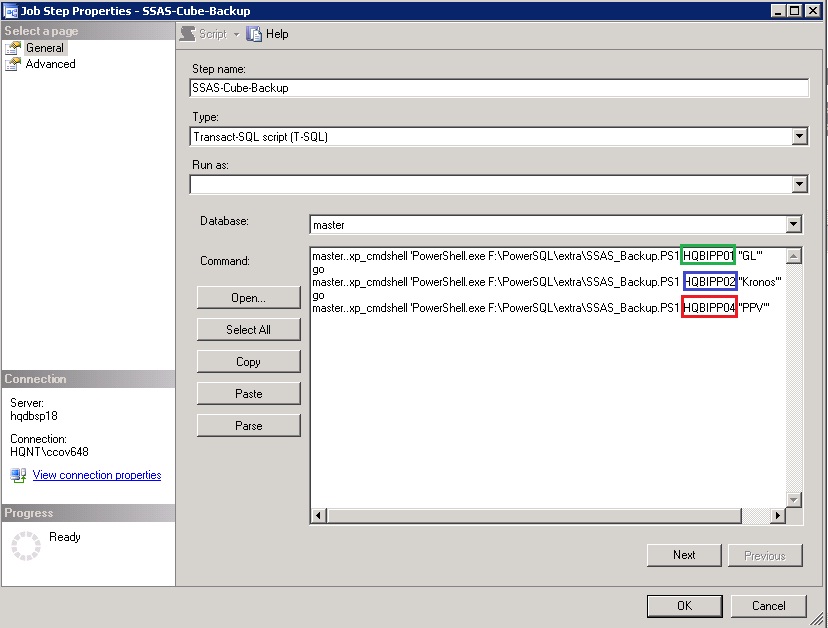
- One place to refer various methods to create backup of analysis services cube databases
- Retention period customization for all files and also for specific cube database backup file
- Backup Compression
- Backup to local or remote or fileshare
- Effective backup strategy is always good for a Disaster Recovery
Reference
Basic SSAS backup using SSMS
SQLAgent, ASCMD and XMLA Script
SSIS
PowerShell AMO
Backup Basics
Load snapins
